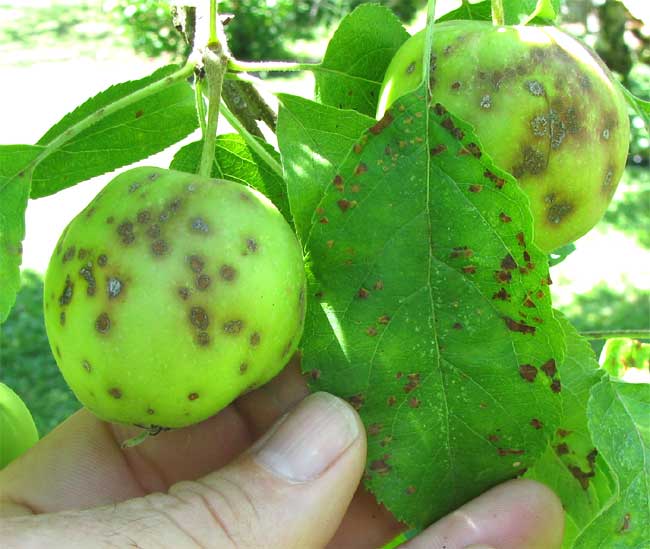Excerpts from Jim Conrad's
Naturalist Newsletter

from the August 2, 2009 Newsletter, issued from the Siskiyou Mountains west of Grants Pass, Oregon:
APPLE SCAB
Some apple trees here are infected with apple scab disease, the symptoms on leaves and fruits shown above. The "scabs" occur not only on apples and leaves but also on petioles, pedicels, and twigs. The disease organism responsible for this is a fungus, VENTURIA INAEQUALIS, and besides apples it infects pear, firethorn, and hawthorn. Here's how it works:
In spring when the temperature and humidity are just right -- about when tree buds are turning green before sprouting -- spores are released from infected leaves that have overwintered beneath the tree. The spores land on trees, germinate, and send rootlike hyphae into developing tissue.
As the hyphae mature they sprout asexual reproductive structures called conidia, which produce conidial spores. Conidial spores are unlike the spores we started with, so we're talking about two kinds of spores here, the first being special "ascospores" resulting from sex, the second being more like dusty fragments budding off vegetatively. We're seeing the asexual conidia-forming stage in picture. Notice that certain spots have gray fringes. That's where conidial spores are being produced.
The conidial spores cause secondary infections, causing the disease to get worse and worse through the summer. Eventually the apples may have much larger spots that crack open, and the apples themselves may be deformed. The tree's leaves may fall early, weakening the tree.
Venturia inaequalis overwinters mostly on fallen leaves, in immature fruiting bodies known as pseudothecia. This is where sexual reproduction takes place so that the following spring a new generation of ascospores can be released, starting the disease all over again. Scab lesions on woody parts may also overwinter, not undergoing sexual reproduction cycle. However, their production of conidial spores may continue the following spring.
Our first line of defense against apple scab is to plant resistant tree varieties, among which are Enterprise, Goldrush, Liberty, Jonafree, Macfree, Prima, Pristine, Redfree, and Sir Prize. The second most useful strategy is to rake up and burn all leaves below infected trees in the fall. After that, typical advice is to use copper- and/or sulfur-based fungicides per instructions. I personally don't like copper-based solutions, such as Bordeaux Mixture, because of copper's toxic effects as outlined at this link